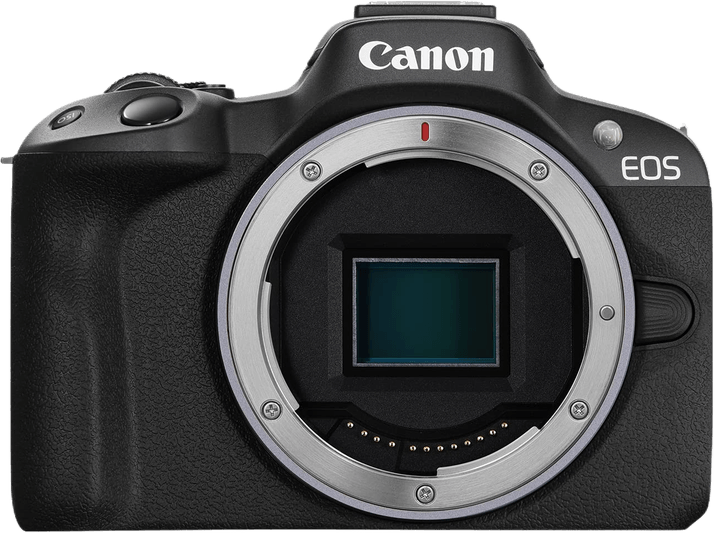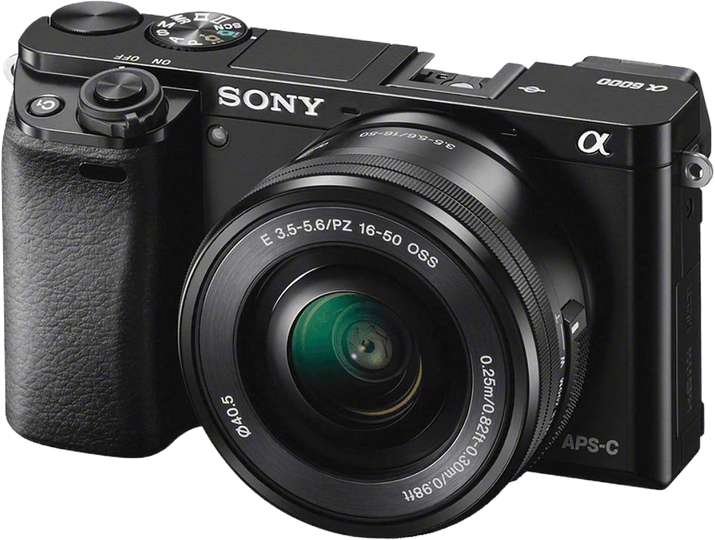Canon EOS R50 vs Sony a6000 Comparison
Canon EOS R50

Sony a6000

The Canon EOS R50 outperforms the Sony a6000 with a score of 70/100 compared to 57/100. Both cameras are mirrorless and have similar sizes, with the EOS R50 measuring 116 x 86 x 69mm and the a6000 at 120 x 67 x 45mm. They also have comparable weights, with the EOS R50 weighing 375g and the a6000 at 344g.
The Canon EOS R50 excels with its more recent release year of 2023 and a lower launch price of $679, compared to the a6000’s 2014 release and $799 price. However, the Sony a6000 has a slight advantage in terms of size and weight, being slightly lighter and more compact.
Taking into account the specifications, the Canon EOS R50 is the better choice due to its improved features, competitive price, and up-to-date technology. While the Sony a6000 has its merits in terms of portability, the overall winner is the Canon EOS R50.
Canon EOS R50 vs Sony a6000 Overview and Optics
The Canon EOS R50 outperforms the Sony a6000 in optics with a score of 73/100 compared to the a6000’s 67/100. Both cameras share some common specifications, such as 24-megapixel CMOS sensors, lack of image stabilization, and APS-C sensor size. However, the EOS R50 has a superior Digic X processor and a higher DXOMARK score for its sensor, which contribute to its winning edge.
The EOS R50’s Digic X processor allows for faster image processing and better overall performance compared to the a6000’s Bionz X processor. Additionally, the R50’s higher DXOMARK sensor score of 94 (versus the a6000’s 82) indicates that the camera can produce higher quality images with better dynamic range, color depth, and low-light performance.
The Sony a6000, however, has a slightly higher megapixel count of 24.3 compared to the R50’s 24. This difference is minimal and may not be noticeable in most situations. The a6000 also has a slightly slower shooting speed of 11 frames per second (fps) compared to the R50’s 12 fps, but this difference is not significant enough to impact performance in most situations.
Regarding lens compatibility, the Canon EOS R50 uses the Canon RF lens mount, while the Sony a6000 uses the Sony E lens mount. This difference may be a factor in choosing between the two cameras, depending on the user’s existing lens collection and preferences.
Comparing the optics of the Canon EOS R50 and the Sony a6000, the R50 emerges as the superior choice due to its better processor and sensor performance. The a6000 has minimal advantages in megapixel count and shooting speed, but these differences are not significant enough to outweigh the R50’s strengths. Ultimately, the choice between these two cameras will depend on individual preferences and priorities, such as lens compatibility and budget.
Canon EOS R50 vs Sony a6000 Video Performance
The Canon EOS R50 outperforms the Sony a6000 in video capabilities, scoring 91 out of 100, compared to the Sony a6000’s score of 56. Both cameras have distinct features and advantages, which we will examine below.
The Canon EOS R50 and Sony a6000 share some video specifications. Both cameras offer autofocus during video recording, ensuring sharp and clear footage. Additionally, they both have microphone inputs, allowing users to capture high-quality audio.
However, the Canon EOS R50 surpasses the Sony a6000 in several aspects. The R50 has a maximum video resolution of 4K (3840 x 2160), while the a6000 only reaches Full HD (1920 x 1080). This difference enables the R50 to produce more detailed and visually appealing videos. Furthermore, the R50 boasts a higher maximum video frame rate of 120fps, compared to the a6000’s 60fps. This higher frame rate allows for smoother footage and impressive slow-motion effects. Lastly, the R50 has built-in time-lapse functionality, a feature absent in the a6000, providing creative options for videographers.
Despite its lower score, the Sony a6000 still has some advantages. It is a more compact and lightweight camera, making it easier to carry around and use for extended periods. Additionally, the a6000 is more affordable than the R50, making it an attractive option for those on a tighter budget.
Taking these factors into account, the Canon EOS R50 is the superior choice for users prioritizing video capabilities, offering higher resolution, faster frame rates, and time-lapse functionality. However, the Sony a6000 may still appeal to those who value portability and affordability over advanced video features.
Canon EOS R50 vs Sony a6000 Features and Benefits
The Canon EOS R50 takes the lead with a feature score of 72/100, while the Sony a6000 lags behind at 41/100. Both cameras share some common specifications, including a 3-inch screen size, flip screen, no GPS, and WIFI connectivity.
The Canon EOS R50 excels in several areas, such as screen resolution and connectivity. With a screen resolution of 1,620,000 dots, the R50 offers a much clearer and sharper display compared to the a6000’s 921,600 dots. Additionally, the R50’s touchscreen functionality provides users with easier navigation and control over the camera settings. Furthermore, the R50 has Bluetooth connectivity, which enhances its wireless capabilities, allowing for seamless pairing with other devices and remote control options.
On the other hand, the Sony a6000 has some advantages as well. Both cameras lack GPS, but the a6000’s flip screen is a useful feature for capturing images from various angles and for vlogging purposes. However, the a6000 falls short in terms of screen resolution and connectivity options compared to the R50.
Considering the differences in feature scores and specifications, the Canon EOS R50 emerges as the superior camera. Its high-resolution touchscreen and Bluetooth connectivity contribute to its higher score and better overall performance. While the Sony a6000 has some useful features, such as the flip screen, it struggles to compete with the R50 in terms of screen resolution and connectivity options. Therefore, the Canon EOS R50 stands out as the better choice for photographers seeking more advanced features and better performance.
Canon EOS R50 vs Sony a6000 Storage and Battery
The Canon EOS R50 outperforms the Sony a6000 in storage and battery with a score of 35/100 compared to 21/100. Both cameras have one memory card slot and accept SD, SDHC, and SDXC cards. However, the Sony a6000 also accepts Memory Stick Pro Duo and Pro-HG Duo cards.
The Canon EOS R50 has a slightly longer battery life of 370 shots, while the Sony a6000 lasts for 360 shots. The Canon EOS R50 uses an LP-E17 battery, whereas the Sony a6000 uses an NP-FW50 battery. The advantage of the Canon EOS R50 is the USB charging capability, which the Sony a6000 lacks.
Despite the Sony a6000’s lower storage and battery score, it offers more memory card compatibility. However, the Canon EOS R50’s longer battery life and USB charging make it the better option in this category. Both cameras have their strengths, but the Canon EOS R50 takes the lead in terms of storage and battery performance.
Canon EOS R50 vs Sony a6000 – Our Verdict
Are you still undecided about which camera is right for you? Have a look at these popular comparisons that feature the Canon EOS R50 or the Sony a6000:

